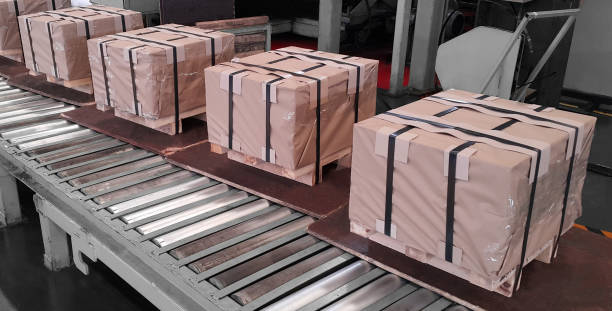Industrial packing and lashing are critical processes in the logistics and transportation industry, especially in a bustling trade hub like Dubai. Proper packing and secure lashing ensure that goods remain safe during transit, preventing damage and loss. This blog will explore the key techniques and materials used in Industrial Packing & Lashing, focusing on best practices that help maintain cargo integrity and improve efficiency.
What is Industrial Packing and Lashing?
Understanding Industrial Packing
Industrial packing involves the preparation of goods for transportation or storage using specialized materials and methods. It protects products from environmental factors, shocks, and vibrations during handling and shipping. Packing varies depending on the type of cargo, its size, weight, and fragility.
Understanding Industrial Lashing
Lashing refers to securing cargo to a vehicle, container, or ship to prevent movement during transport. It involves using straps, ropes, chains, or wires to tie down goods firmly. Lashing is essential in industries where heavy machinery, large containers, or irregularly shaped items are moved.
Common Packing Techniques in Dubai’s Industrial Sector
Cushioning and Wrapping
One of the most used packing techniques involves cushioning fragile items with foam, bubble wrap, or corrugated sheets. This layer absorbs shocks and protects goods from scratches and impacts. Wrapping helps keep the cushioning in place and shields the product from dust and moisture.
Crating and Palletizing
Crates and pallets are widely used for packing heavy and bulky goods. Wooden or plastic crates offer solid protection by enclosing items securely. Palletizing involves stacking goods on pallets, which makes handling with forklifts easier. It also helps organize cargo for efficient loading and unloading.
Containerization
Containerization is a preferred technique for long-distance shipping. Goods are packed into standardized metal containers that protect them from weather and rough handling. Containers also simplify customs inspections and reduce theft risks.
Effective Lashing Methods for Secure Cargo
Strap Lashing
Strap lashing uses polyester or nylon straps with ratchet mechanisms to tighten the straps around cargo. This method is popular due to its strength, flexibility, and ease of use. Straps are resistant to stretching and abrasion, making them suitable for securing a variety of goods.
Chain Lashing
For extremely heavy or oversized loads, chain lashing is preferred. Steel chains and tensioners provide maximum security for transporting heavy machinery, construction equipment, and steel coils. Chains are durable but require careful handling to avoid damaging the cargo or vehicle.
Rope and Wire Lashing
Ropes, often made from synthetic fibers like polypropylene or natural fibers like sisal, are used for lighter loads. Wire lashing, made of steel cables, offers a balance between strength and flexibility. Both are commonly used in securing irregularly shaped cargo or stacked goods.
Materials Used in Industrial Packing and Lashing
Wood and Plywood
Wooden crates and pallets made from solid timber or plywood are essential packing materials. They offer robust protection against impacts and allow easy customizations for different cargo sizes. Dubai’s industrial sector often sources high-quality wood to meet international shipping standards.
Foam and Bubble Wrap
Foam sheets and bubble wrap provide cushioning for fragile and sensitive items. These materials absorb shocks and reduce vibrations. They are lightweight and easy to handle, making them ideal for electronics, glassware, and delicate instruments.
Straps and Chains
Straps are mostly made from polyester or nylon, which provide elasticity and resistance to weather elements. Chains are made from hardened steel, offering maximum strength and security. Both materials are designed to withstand tension and pressure during transport.
Plastic Films and Tarpaulins
Stretch films and shrink wraps are used to bind palletized cargo tightly. Tarpaulins made from PVC or polyethylene protect goods from rain, dust, and UV rays. In Dubai’s climate, protecting cargo from heat and sand is particularly important.
Industry Standards and Safety Regulations in Dubai
Compliance with International Standards
Dubai’s industrial packing and lashing services comply with international regulations such as the International Maritime Dangerous Goods (IMDG) Code and ISO standards. These guidelines ensure that goods are packed and secured safely to prevent accidents during shipping.
Local Safety Requirements
The Dubai government enforces strict safety rules for cargo handling and transport. These include proper labeling, using certified packing materials, and regular inspections. Adhering to these rules minimizes the risk of damage and liability.
Benefits of Proper Packing and Lashing in Dubai
Protecting Cargo Integrity
Proper packing and lashing prevent damage caused by shocks, vibrations, and weather conditions. This helps preserve the quality of goods and reduces financial losses for businesses.
Enhancing Transport Efficiency
Well-packed and securely lashed cargo allows for easier loading and unloading. It also maximizes space in containers and trucks, reducing transport costs.
Ensuring Safety for Workers and Environment
Secure cargo reduces the risk of accidents during transit, protecting workers and minimizing environmental hazards caused by spills or dropped loads.
Conclusion
In Dubai’s fast-growing industrial and logistics sectors, mastering the techniques and materials of industrial packing and lashing is essential. Using appropriate packing methods and durable materials ensures the safe delivery of goods, boosts operational efficiency, and complies with safety regulations. Whether handling fragile electronics or heavy machinery, the right approach to packing and lashing makes all the difference in successful cargo transport.


